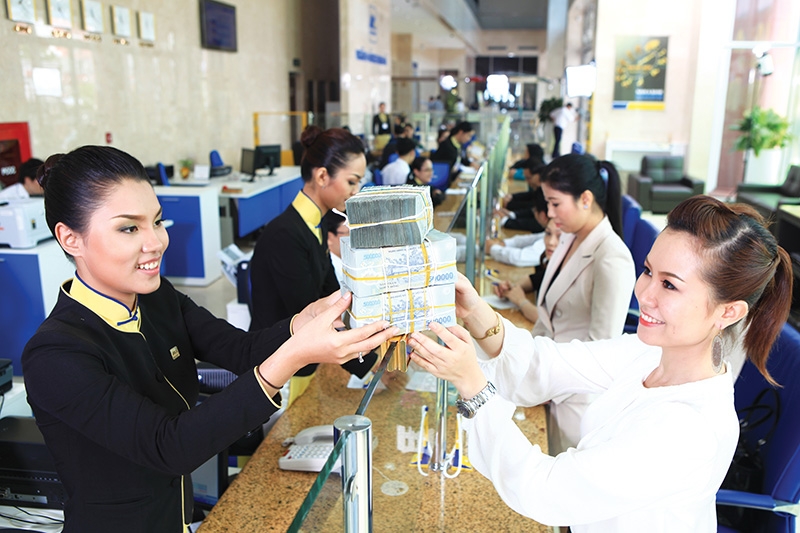Central bank continues growth drive amid global uncertainties
 |
| Rates were cut last year to aid struggling businesses, photo Le Toan |
HSBC economist Yun Liu stated that given Vietnam’s limited fiscal space, the monetary policy has done most of the heavy lifting to drive growth.
“As Vietnam’s economy is set for robust recovery in the coming quarters, we expect the central bank to keep its monetary policy on hold until June 2022, before possibly delivering a 25-basis-point hike, bringing its refinancing rate to 4.25 per cent by the year-end,” she forecast.
In 2020, the State Bank of Vietnam (SBV) cut rates thrice to help vulnerable businesses weather the storm. The latest cut was in September when the SBV dropped its annual refinancing rate by another 50 basis points, bringing it down to 4 per cent. The magnitude of the cut signalled the central bank’s sense of urgency, given the government’s 2020 growth target of 2.5-3 per cent.
Data from Vietnam’s provider of financial data Fiingroup revealed that deposit rates continued the downward trajectory in December for both 6-month and 12-month terms in most banking sectors.
For 6-month rates, the interest rates of state-owned banks and small-sized commercial banks such as ABBank and Kien Long Bank decreased by 0.135 and 0.1 per cent, respectively, to 3.75 and 5.66 per cent per year.
In contrast, large joint-stock commercial banks such as Techcombank and VPBank were the only ones with average annual interest rates increasing, by 0.04 per cent to 4.93 per cent. Vietcombank currently offers the lowest deposit rate in the market at 3.6 per cent per year, while National Citizen Bank pays the most with 6.65 per cent.
Meanwhile, according to Bao Viet Securities JSC (BVSC), for 12-month rates, the average deposit rates of all three banking groups shared the same decline. The rates of state-owned banks dropped the most (down 0.325 per cent to 5.03 per cent per year). Interest rates of small and large joint-stock commercial banks decreased by 0.13 and 0.145 per cent, respectively, to 6.29 and 5.71 per cent per year.
The lowest interest rate can be found at Techcombank (4.6 per cent) and the highest at National Citizen Bank, HDBank, and Indovina Bank (6.9 per cent). Thus, the average 6-month and 12-month interest rates of the whole banking industry are 5.03 and 5.83 per cent, both down 1.3 per cent compared to the end of 2019.
BVSC believed that the SBV will maintain its current monetary policy without adding pressure. Therefore, the long-term interest rate in 2021 is expected to remain stable at the low end-of-2020 level.
Low deposit rates could be an impetus for credit institutions thanks to the reduction of capital costs and increasing profits. In fact, since the third quarter of 2020, the profit margins of many commercial banks increased due to historic low deposit interest rates while the interest rates did not fall correspondingly.
While Vietnam is poised to outperform the region in 2021, there are several risks to its economic recovery.
Yun Liu from HSBC believed tourism prospects remain bleak. “Even though the worst has likely passed in the second quarter, tourism-related services such as accommodation and transportation will remain in the doldrums. This is not surprising, given ongoing border restrictions, despite the select travel arrangements Vietnam has with neighbouring countries,” she explained.
Although the second wave was quickly contained, it likely made the government more cautious about reopening the borders and welcoming international tourists, Liu added. As such, there is unlikely to be meaningful recovery in the sector in the near term, at least until there is an effective vaccine and a coordinated global approach to international travel.
“Domestically, Vietnam’s soft labour market remains a challenge. Despite some improvements in the third quarter, unemployment rates remained elevated with lower wages. If this continues, it will likely result in a prolonged recovery in consumer spending, which has been a key pillar of growth,” said Liu.
On the other hand, the SBV has modified its exchange rate management policy. Since December 31 it stopped listing spot bid-rates of USD/VND at its Operations Centre and deferred foreign exchange spot purchases.
Besides, from January 4, 2021, the central bank has started buying 6-month forward contracts (instead of 3-month term ones as before) for VND23,125 per USD with requirement for cancellation.
Moreover, stopping the bid-rate listing at the Operations Centre will remove the support for the VND to appreciate.
Thai Thi Viet Trinh, analyst at KB Securities, noted that deferring forex spot purchases shows that the SBV is no longer willing to buy USD to accumulate forex reserves.
“Commercial banks, thus, need to actively contact the central bank in case of a large positive forex position and if there is any, the spot purchase of USD will most likely take place on a case-by-case basis,” Trinh said.
What the stars mean:
★ Poor ★ ★ Promising ★★★ Good ★★★★ Very good ★★★★★ Exceptional
Related Contents
Latest News
More News
- PM orders investment model for North–South high-speed rail (December 22, 2025 | 17:43)
- First members of Danang International Finance Centre revealed (December 22, 2025 | 17:39)
- Securing capital and efficiency for Vietnam’s 2026-2030 growth ambitions (December 17, 2025 | 10:00)
- Driving double-digit growth through green and circular transformation in Vietnam (December 17, 2025 | 09:00)
- Vietnam bucking trend in the global M&A landscape (December 16, 2025 | 14:20)
- Vietnam’s green transition demands collective financial action (December 15, 2025 | 12:00)
- VIR workshop highlights capital and policy for sustainable development (December 15, 2025 | 11:00)
- National Assembly approves pilot mechanisms to accelerate major projects in Hanoi (December 12, 2025 | 11:29)
- Vietnam eases policy approval requirements, simplifies foreign and outbound investments (December 11, 2025 | 17:53)
- Unpacking new momentum in Vietnam’s M&A market (December 10, 2025 | 09:59)

 Tag:
Tag:





















 Mobile Version
Mobile Version